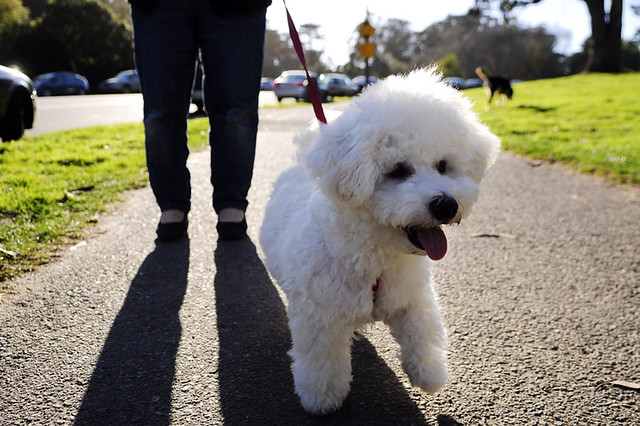
Some San Francisco residents might find it difficult to imagine places like Fort Funston and Ocean Beach without dogs running freely along the coastline.
But that vision may change if the Golden Gate National Recreation Area adopts a proposed plan that would limit where dogs are allowed off their leashes in San Francisco parks.
GGNRA spokeswoman Alexandria Picavet said the intent of the plan is to balance the desires of both types of park visitors: those who enjoy bringing and being around dogs and those who do not.
“What we’ve tried to do is strike balance with the proposal,” Picavet said. “We’ve received complaints from people who felt that there wasn’t any place to go where there weren’t dogs off leash.”
Some dog owners, however, are unhappy with the proposal.
Martha Walters, co-founder and chair of Crissy Field Dog Group, said the plan is restrictive.
“The plan for Crissy Field, for example, is a 75 percent reduction, and the same for Fort Funston,” Walters said. “It’s not practical, it’s not pragmatic. People are going to be bringing their dogs anyway. The park service is being unrealistic.”
The GGNRA encompasses parks from Marin County to Half Moon Bay. The Draft Environmental Impact Statement includes alternative plans to the current dog-walking policy within the parks. The GGNRA prefers an alternative plan that would restrict off-leash access to various sites and would ban dogs completely in certain parts of Fort Funston and on the area of Ocean Beach south of Sloat Boulevard.
Keeping dogs healthy is mandated by a San Francisco health code that requires owners to provide all dogs with adequate exercise. Off-leash access is key in that regard, according Suzanne Valente, a member of the Ocean Beach Dog Owners Group.
“Dogs need the sort of extreme exercise you can only get off leash,” Valente said. “If you don’t give children attention and exercise, they get cranky. Pets aren’t any different.”
The benefits of off-leash access are not only for the dogs, but also for owners as well, according to Valente.
“Having a dog encourages people to exercise,” she said. “Pets in general help people mentally with stress. The economy’s not doing good right now. A lot of people are struggling, and pets help them get through difficult times.”
Valente said that people who are against off-leash access have misconceptions about the fierce nature of dogs.
“People think off-leash is like dogs running wild or mayhem, and it’s people playing fetch or running with their dog,” she said.
The concern for management of dog activity in the Bay Area began with the 1979 pet policy, according to Picavet.
“It isn’t a law or rule; it was a recommendation and was what we operated under for a long time,” Picavet said.
In 2000, a lawsuit was filed against the GGNRA when part of Fort Funston was closed to the public. The court declared the National Park Service had not adequately obtained public comment as required by federal law in order to close the area.
In January 2001, the GGNRA acknowledged that federal law prohibits dogs to be off-leash in national parks, which sparked the debate over the current dog policy.
Picavet said that GGNRA’s off-leash program is unique in comparison to other parks.
“We’ll be the only national park to offer off-leash areas for dog walking,” she said.
Stephen Sayad, the attorney for OBDOG, said that the GGNRA is trying to turn the parks into something for which they were never intended.
“This is not a traditional national park,” Sayad said. “It wasn’t set up that way like Yosemite or Yellowstone, where it’s really ‘look, but don’t touch.’ This was set up as a unique urban recreation park, which is not to say the natural resources aren’t to be protected.”
The GGNRA has said one of their environmental concerns involves the preservation of wildlife, including the endangered western snowy plover, a small sparrow-like shore bird that frequents Bay Area coasts. But off-leash proponents contend that dogs are not the sole contributor to the plover’s dwindling numbers.
“They’ve never looked at anything other than the effect of dogs on plovers,” Sayad said. “They’re not after cyclists or people running on the beach, they’re looking at dogs. Both crows and sparrows are some of the biggest predators of the plover, and they’ve been inundating Ocean Beach because of garbage that’s left on Great Highway.”
Currently there is a 90-day open comment period on the proposal that lasts until April 14. The GGNRA is expected to formalize the final plan in coming months.
“What we’re hoping for is public comment,” Picavet said. “‘I hate the plan’ is not an effective comment. Saying ‘this is what the plan needs to fulfill my needs’ and actually comment on it in a way that’s useful in our developing and finishing of our final plan (is the idea.) This plan affects everybody and how everybody will experience Golden Gate in the future for the next 20 years.”
Picavet said that at the end of the comment period the organization will review the feedback and address concerns in a final statement.
Open house GGNRA meetings on the proposed plan will be held March 5 from 11 a.m. to 4 p.m., at SF State in the Seven Hills Conference Center and March 7 from 4 to 8 p.m. at Fort Mason Center Building A Conference Center.
Other meetings will take place in Pacifica and Marin. Comments can be made on the National Park Service’s website at http://parkplanning.nps.gov/.



